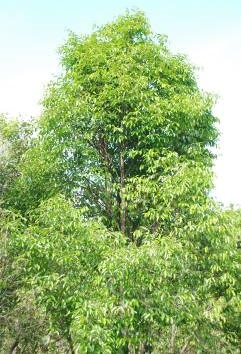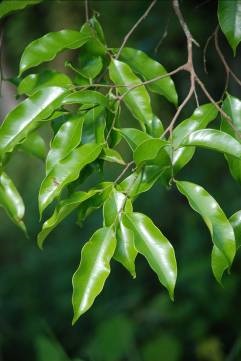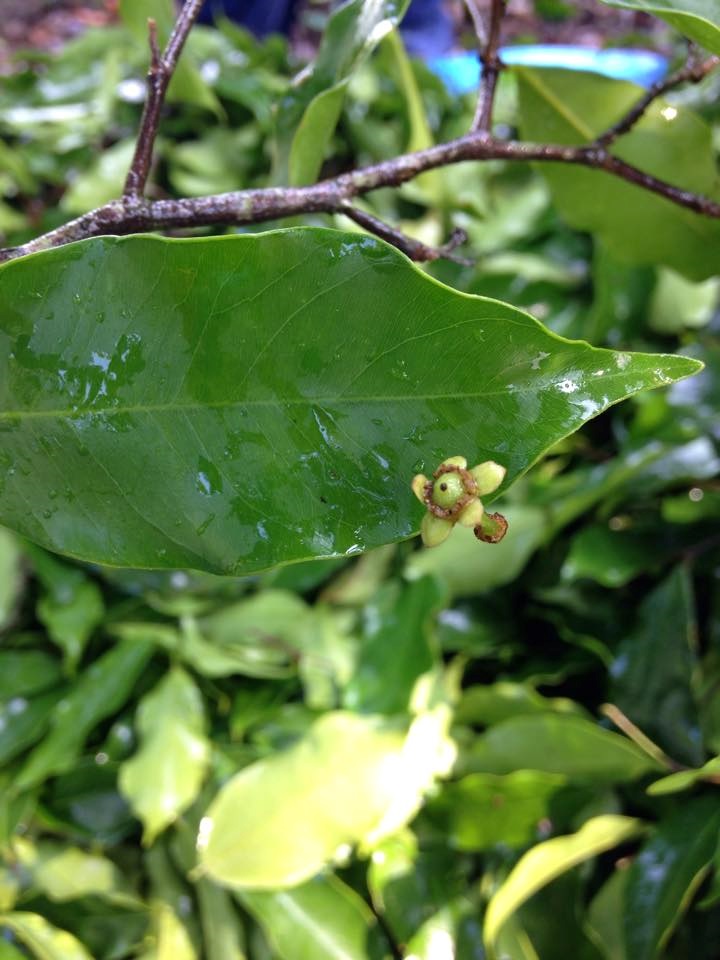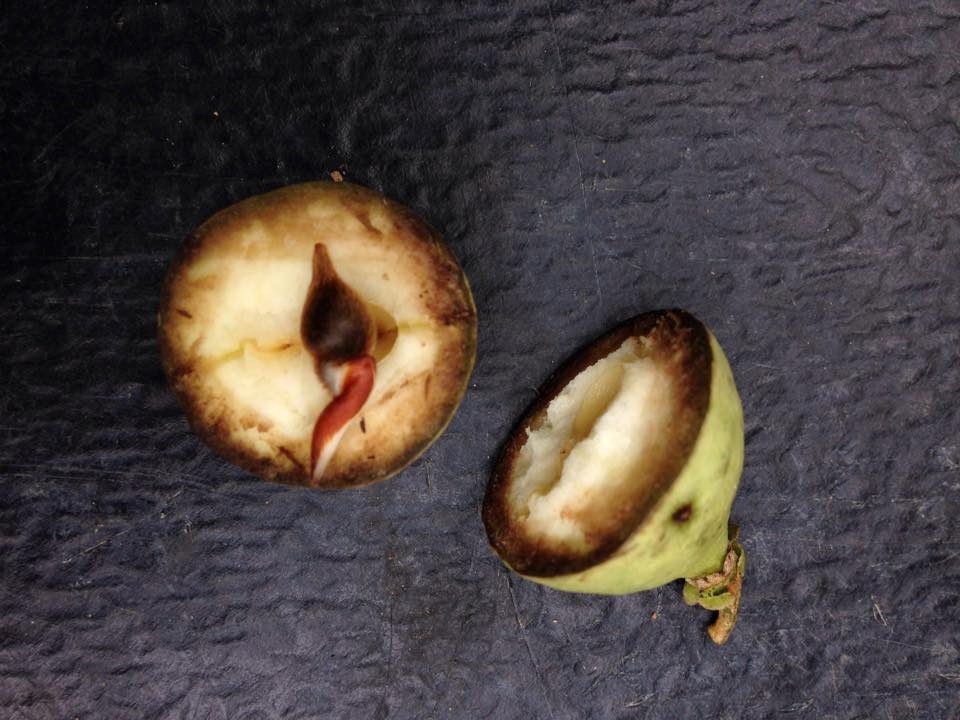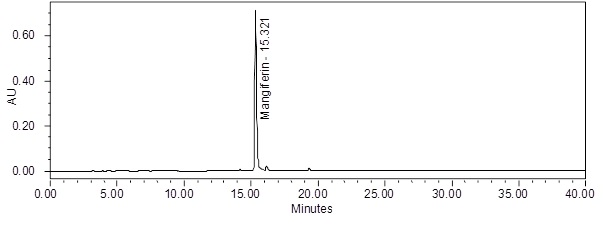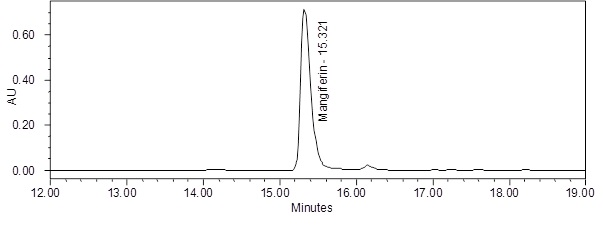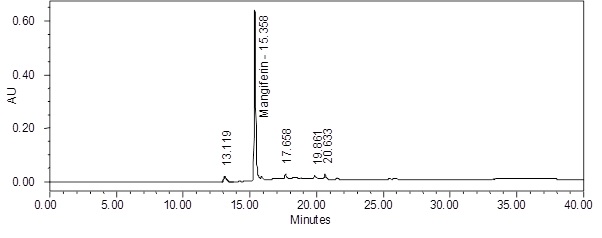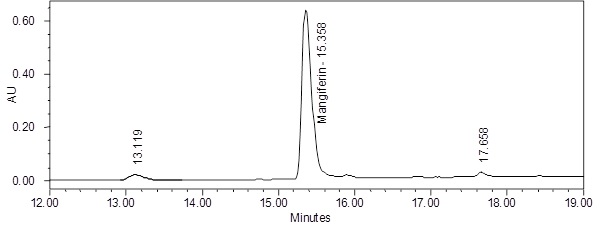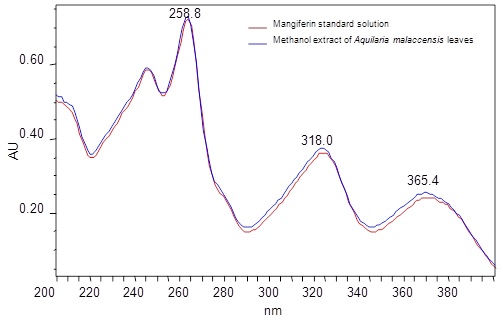Karas Leaves
Aquilaria malaccensis Lamk.
Thymelaeceae
DEFINITION
Karas leaves consist of dried leaves of Aquilaria malaccensis Lamk. (Thymelaeceae).
SYNONYM
Aquilaria agallocha Roxb., Agallochum malaccense (Lamk) Kuntze, Aquilariella malaccensis (Lamk) v. Tieghem [ 1 ].
VERNACULAR NAMES
Agar wood, malayan aloes-wood, malayan eaglewood (English); karas, gaharu, tengkaras (Malay); akil kattai (Tamil) [ 1 , 2 ].
CHARACTER
| Colour | Greenish brown (powder) |
| Odour | Characteristic |
| Taste | Very bitter |
IDENTIFICATION
Plant Morphology
A. malaccensis is a tree, up to 20(–40) m tall; bark smooth, whitish. Leaves simple, alternate; petiole 4–6 mm long; blade elliptical-oblong to oblong-lanceolate, 7.5–12 cm x 2.5–5.5 cm, glabrous, sometimes pubescent and glabrescent beneath, shiny on both surfaces, base acute, attenuate or obtuse, apex acuminate, veins in 12–16 pairs, rather irregular, often branched, elevated and distinct beneath, curving upward to the margin, plane or obscure above. Inflorescence terminal, axillary or supra-axillary, sometimes internodal umbel, usually branched into 2–3 umbels, each with about 10 flowers; peduncle 5–15 mm long; pedicel slender, 3–6 mm long. Flowers usually 5-merous, campanulate, 5–6 mm long, green or dirty-yellow, scattered puberulous outside; floral tube nearly glabrous inside, distinctly 10-ribbed, persistent in fruit; calyx lobes 5, ovate-oblong, 2–3 mm long, almost as long as the tube, densely puberulous within; petaloid appendages 10, inserted at the throat of the tube, oblong or slightly ovate-oblong, about 1 mm long, slightly incurved, densely pilose; stamens 10, free, emerging from the throat of the tube, filamentous, 1.2–2 mm long, episepalous ones longer than the others; anthers linear, obtuse; pistil included; ovary ovoid, 1–1.5 mm long, 2-celled, densely pubescent; style obscure, stigma capitate. Fruit a loculicidal capsule, obovoid or obovoid-cylindrical, 3–4 cm x 2.5 cm, usually compressed, pubescent, glabrescent, base cuneate, apex rounded; pericarp woody. Seed ovoid, 10 mm x 6 mm including a beak 4 mm long, densely red-haired, bearing from the base a twisted, tail-like, pubescent appendage as long as the seed; seedling with epigeal germination [ 1 , 3 ].
Microscopy
Powdered material consists of abundant epidermis cells with straight to wavy anticlinal walled; also attached with stomata. Fragments of vessels with simple pitted, spiral and scalariform vessels with dark brown contents. Calcium oxalate crystals in prismatic and solitary form; sometimes attached with vessels and fibers [ 2 ].
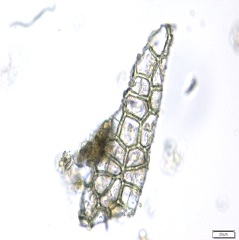
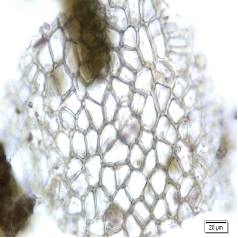
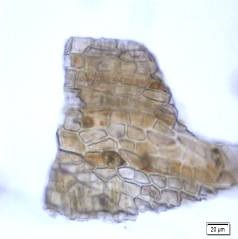
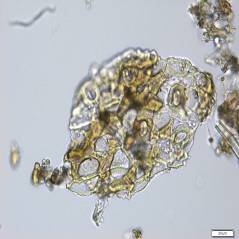
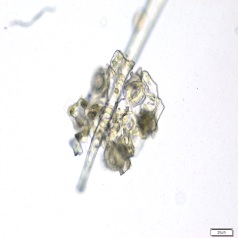
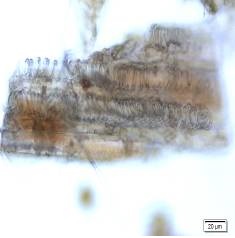
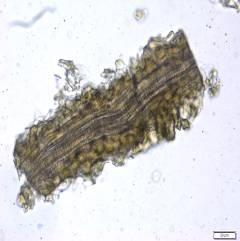
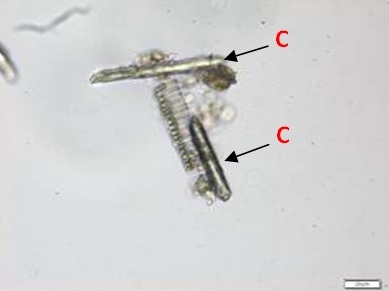
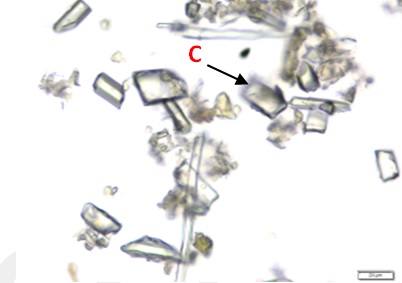
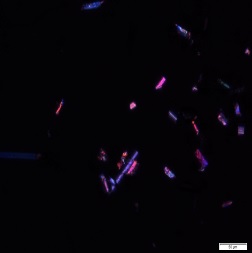
Figure 2 : Microscopic characters of A. malaccensis leaves powder. (a-c) Epidermis cells (magnification 20x); (d-e) epidermis cells attached with stomata; (f-g) scalariform vessel cells (magnification 20x); (h-i) prismatic and solitary crystals [C]; spiral vessel cell and fibers (magnification 20x); (j) prismatic and solitary crystals [C] under polarizing filter (magnification 20x). [Scale bars: a-c, e-j = 20 µm; d = 100 µm]
Colour Tests
Observed colour of solution after treatment with various reagents:
| H2SO4 (conc.) | Brown |
| NaOH (5%) | Yellow |
Thin Layer Chromatography (TLC)
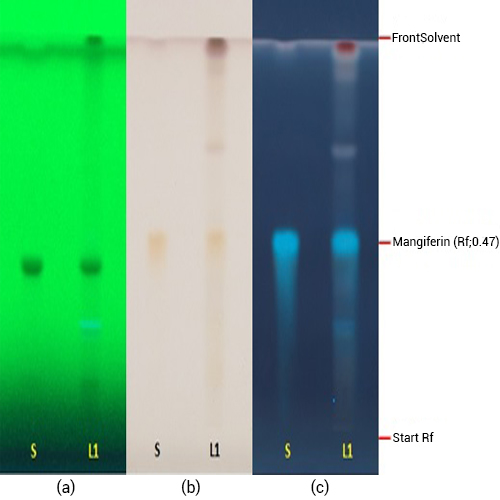
Figure 3 : TLC profiles of mangiferin (S) and methanol extracts of A. malaccensis dried leaves powder (L1) observed under (a) UV at 254 nm before spray, (b) daylight after spray and (c) UV 366 nm after spray.
| Test Solutions | Weigh about 0.5 g of A. malaccensis dried leaves powder in a 50 mL screwed cap bottle and add 5 mL of methanol. Ultrasonicate the mixture for 15 min. Cool the mixture at room temperature and filter the solution with filter 0.45 µm into a vial. Use the filtrate as test solution. |
| Standard solution | Dissolve mangiferin (CAS no.: 4773-96-0) in methanol to produce a solution containing 1 mg/mL. |
| Stationary Phase | HPTLC glass silica gel 60 F254, 20 x 10 cm |
| Mobile phase | Ethyl acetate : formic acid : acetic acid : water (100 : 11 : 11 : 25), 20 mL (v/v/v/v) |
| Application |
|
| Development distance | 8 cm, automatic developing chamber 2 (ADC2) |
| Drying | Air drying |
| Detection |
|
High Performance Liquid Chromatography (HPLC)
| Test solution | Weigh 0.5 g of A. malaccensis dried powder in glass vial with screw cap. Add 5 mL of methanol and ultrasonicate for 15 min. Filter through 0.45 µm syringe filter and use the filtrate for HPLC analysis. | ||||||||||||||||||||||||||||
| Standard solution | Dissolve mangiferin (CAS no.: 4773-96-0) in methanol to produce a solution containing 1 mg/mL. | ||||||||||||||||||||||||||||
| Chromatographic system |
Detector: UV 254 nm Column: C18 (5 µm, 4.6 mm i.d. x 250 mm) (preferably Luna C18, Phenomenex) Column oven temperature: Ambient Flow rate: 1.0 mL/min Injection volume: 1 µL (test solution), 5 µl (standard solution) |
||||||||||||||||||||||||||||
| Mobile Phase (gradient mode) |
|
||||||||||||||||||||||||||||
| System suitability requirement |
Perform at least five replicate injections of the standard solutions (1 mg/mL). The requirements of the system suitability parameters are as follow:
|
||||||||||||||||||||||||||||
| Acceptance criteria |
|
PURITY TESTS
| Foreign Matter |
| Not more than 2% |
| Ash Contents | |
| Total ash | Not more than 6% |
| Acid-insoluble ash | Not more than 1% |
| Loss on Drying |
| Not more than 11% |
| Extractive Values | |
| Water-soluble extracts | |
| Hot method | Not less than 22% |
| Cold method | Not less than 16% |
| Ethanol-soluble extracts | |
| Hot method | Not less than 19% |
| Cold method | Not less than 12% |
SAFETY TESTS
| Heavy Metals | |
| Arsenic | Not more than 5.0 mg/kg |
| Mercury | Not more than 0.5 mg/kg |
| Lead | Not more than 10.0 mg/kg |
| Cadmium | Not more than 0.3 mg/kg |
| Microbial Limits | |
| Total bacterial count | Not more than 105 cfu/g |
| Total yeast and mould count | Not more than 104 cfu/g |
| Bile-tolerant gram negative | Not more than 104 cfu/g |
| Specific Pathogens | |
| Salmonella spp. | Absent in 25 g |
| Escherichia coli | Absent in 1 g |
| Staphylococcus aureus | Absent in 1 g |
| Pseudomonas aeruginosa | Absent in 1 g |
CHEMICAL CONSTITUENTS
Methanolic extract of A. malaccensis leaves has been found to contain fatty acids (e.g. n-hexadecanoic acid and 9,12,15-octadecatrienoic acid (z,z,z)-, fatty alcohols (e.g. 3,7,11,15-tetramethyl-2-hexadecen-1-ol (phytol) and 1-tetradecanol), polyol (e.g. glycerine), pyrone (e.g. 2,3-dihydro-3,5-dihydroxy-6-methyl-4H-pyran-4-one), quinone (e.g. 6-ethyl-5-hydroxy-2,3n,7-trimethoxynaphthoquinone), triterpene (e.g. squalene) and others (2-propanone,1,2,dihydroxy, dodecyl acrylate and octaethylene glycol monodecyl ether) [ 4 ].
The methanolic extract was also found to contain xanthone (e.g. mangiferin) [ 5 ].
MEDICINAL USES
Uses described in folk medicine, not supported by experimental or clinical data
Information and data have not been established.
Biological and pharmacological activities supported by experimental data
Antioxidant activity
Crude extracts of A. malaccensis leaves (0.156 to 10.000 μg/mL) showed 2,2-diphenyl-1-picrylhydrazyl (DPPH) free radical scavenging activity with IC50 values of 800 µg/mL, 160 µg/mL, 140 µg/mL and 30 µg/mL for the hexane, dichloromethane, ethyl acetate and methanol extract, respectively as compared to quercetin (IC50 = 3.33 µg/mL) [ 6 ].
Hepatoprotective activity
Ethanol (95%) extract of A. malaccensis leaves (200 and 400 mg/kg) administered orally to rats (150 to 200 g) for a duration of ten days after induction of liver toxicity using carbon tetrachloride (CCl4) significantly (p < 0.05) decreased the level of aspartate transaminase (AST: 242.00 ± 4.86 U/L), alanine transaminase (ALT: 153.17 ± 3.77 U/L) and alkaline phosphates (ALP: 88.90 ± 4.98 U/L) compared to the carbon tetrachloride-treated control group (AST: 300.30 ± 5.78 U/L, ALT: 252.0 ± 5.84 U/L, ALP: 111.5 ± 4.22 U/L) [ 7 ].
Antibacterial activity
Aqueous extract of A. malaccensis leaves (50 mg/mL) showed antibacterial effect against Shigella flexneri with inhibition zone 18 mm compared to gentamicin (10 mm) using agar diffusion assay [ 8 ].
Methanol extract of A. malaccensis leaves (50 mg/mL) showed antibacterial effect to Bacillus subtilis with inhibition zone 19 mm compared to gentamicin (10 mm) using agar diffusion assay [ 8 ].
Clinical studies
Information and data have not been established.
SAFETY INFORMATION
Preclinical studies (Toxicology studies)
Acute toxicity
Oral single dose acute toxicity study using aqueous extract of A. malaccensis leaves on female Sprague Dawley rats (aged between 8 and 12 weeks old) showed no toxic effect on the parameters observed which includes behaviors, body weight, food and water intakes. All rats were observed for 14 days prior to necropsy. No death was found throughout the study period. Approximate lethal dose (LD50) is more than 2,000 mg/kg body weight [ 9 ].
Others (Adverse reaction, contraindication, side effect, warning, precaution)
Information and data have not been established.
DOSAGE
Information and data have not been established.
STORAGE
Store below 30°C. Protect from light and moisture.
REFERENCES
- Chung RCK and Purwaningsih. Aquilaria malaccensis Lamk. In: Oyen LPA and Nguyen XD (Editors). Plant Resources of South-East Asia No. 19: Essential-oil plants. Backhuys Publisher, Leiden, The Netherlands. 1999. pp. 64–67.
- Government of India Ministry of Health and Family Welfare Department of Ayush. Agaru (Ht. Wd.). Part 1. Volume 4. 2013. pp. 4-5.
- Wang Y, Nevling LI, Gilbert MG. Flora of China: Thymelaeaceae. Vol. (13). Science Press, Beijing and Missouri Botanical Garden Press, St. Louis. 2008. pp. 214.
- Khalil AS, Rahim AA, Taha KK, Abdallah KB. (2013) Characterization of methanolic extracts of Agarwood leaves. Journal of Applied and Industrial Sciences 2013;1(3):78–88.
- Tan HP, Ling SK, Tan AL, Mohd Faisal IS, Siti Kamariah MH, Nuraini AM. Phytochemical study on the leaves of Aquilaria malaccensis Lam. Paper presented at 17th Malaysian Chemical Congress (17MCC); Kuala Lumpur; 2012 Oct 15-7.
- Huda AWN, Munira MAS, Fitrya SD and Salmah M. Antioxidant activity of Aquilaria malaccensis (Thymelaeaceae) leaves. Pharmacognosy Research 2009;1(5):270–273.
- Vakati K, Rahman H, Eswaraiah MC, Dutta AM. Evaluation of hepatoprotective activity of ethanolic extract of Aquilaria agallocha leaves (EEAA) against CCl4 induced hepatic damage in rat. Scholars Journal of Applied Medical Sciences 2003;1(1):9–12.
- Dash M, Patra JK, Panda PP. Phytochemical and antimicrobial screening of extracts of Aquilaria agallocha Roxb. African Journal of Biotechnology 2008;7:3531–3534.
- Teh BP, Hamzah NF, Norazila Z, Norliyana MY, Wan Abdul Hakim WL. Acute oral toxicity study of selected Malaysian medicinal herbs on Sprague Dawley rats. Institute for Medical Research, Ministry of Health; 2014. Report no.: HMRC 11-045/01/AM/L/B.

